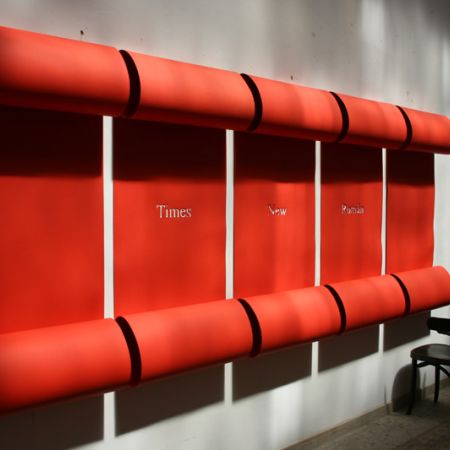Times New Român I
25 September – 1 December 2008
Nextdoor…artGalleria Via di Montoro, 3 00186 Rome, Italy Tel/Fax +39 06 45 42 50 48
e-mail: info@gallerianextdoor.com web: www.gallerianextdoor.com
Opening hours: from Tuesday to Saturday from 1 p.m. to 7 p.m.
Român = Romanian (also the archaic spellings Rumanian and Roumanian) 1. A person that pertains to the basic population of România or that originates from România, a country in South-Eastern Europe.
Romanian is a Romance language spoken by around 24 to 28 million people. The Romanian alphabet is based on the Latin alphabet , and has five additional letters: ă, â, î, ş, ţ, (these are not diacriticals, but letters in their own right).
It is specifically on these linguistic differences between Romanian and other Latin based languages that Alexandru Niculescu is basing his discourse in Times New Român I. A Romanian born artist, Niculescu starts from the premise that although Romanian has five extra letters which endow it with a different sound, it is not at all far from Italian. Furthermore,it is basically the same language but adorned with different ornaments.
Starting from this discourse, the present project investigates the clash between cultures and the socio-political equilibriums between two countries, Romania and Italy, that have the same linguistic base of communication although retaining themselves utterly different. In the midst of the debates based on immigration related problems that currently concern both Italy and Romania, we tend to overlook similarities and a shared history (that of the Romans forming present day Romania by the conquest of Dacia in 105-106 AD). The present tensions are based on the politics of difference and paradoxically, in such moments, it is the infinitesimal difference between two cultures that ignites stigmatizing debates. Although not addressing politics directly, Niculescu metaphorically engages in a discourse on difference and otherness, on difference camouflaged as stigma and on inclusion/ exclusion.
Using painting as his medium, Niculescu analyzes the co-existence of identitarian differences by juxtaposing particularities of the Romanian languages to a general standardized background of the Times New Roman font universally used all over the world. In his latest paintings, the peculiar Romanian vowels ă and â appear as delicate insertions on a background dominated by the uniformity of the Times New Roman. The letters become additions but also off-springs of an alphabet now globally accessible. Although perceived as strange or different they are in fact as frequent and normal as any other foreign diacritics. Therefore Niculescu proposes an image where two languages merge into each other while differences slip in and out of focus, in and out of the common background.
Mirela Pribac

September 2008

































